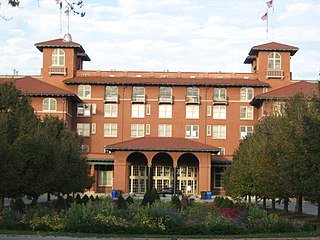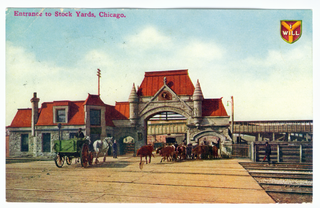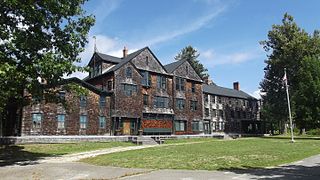
Peoria County is located in the U.S. state of Illinois. The 2020 United States Census listed its population at 181,830. Its county seat is Peoria. Peoria County is part of the Peoria, IL Metropolitan Statistical Area.

Wilmette is a village in New Trier Township, Cook County, Illinois, United States. Bordering Lake Michigan and Evanston, Illinois, it is located 14 miles (23 km) north of Chicago's downtown district. Wilmette had a population of 27,087 at the 2010 census. The first and only Baháʼí House of Worship in North America is located here. Wilmette is also home to Central Elementary School and Romona Elementary School, both recent recipients of the National Blue Ribbon award bestowed by the U.S. Department of Education.

Chillicothe is a city on the Illinois River in Peoria County, Illinois, United States. The population was 6,097 at the 2010 census. Chillicothe is just north of the city of Peoria and is part of the Peoria Metropolitan Statistical Area.

Peoria is the county seat of Peoria County, Illinois, United States, and on the Illinois River. As of the 2020 census, the city had a population of 113,150. It is the principal city of the Peoria Metropolitan Area in Central Illinois, consisting of the counties of Fulton, Marshall, Peoria, Stark, Tazewell, and Woodford, which had a population of 402,391 in 2020.

Gilroy Yamato Hot Springs, a California Historical Landmark and on the list of National Register of Historic Places, is a property near Gilroy, California famed for its mineral hot springs and historic development by early settlers and Japanese immigrants. The earliest extant Italianate–Victorian style structures date from the 1870s, and the earliest bathhouse dates from 1890. Other early structures are a Buddhist shrine from 1939 and a Japanese garden teahouse from that same year. The property is also listed on the National Register of Historic Places. The hot spring's temperature ranges from 99° to 111 °F. These springs are the site of occurrence of certain extremophile micro-organisms, that are capable of surviving in extremely hot environments.

The South Shore Cultural Center, in Chicago, Illinois, is a cultural facility located at 71st Street and South Shore Drive, in the city's South Shore neighborhood. It encompasses the grounds of the former South Shore Country Club.
The Ronald Reagan Trail is a collection of highways in central Illinois that connect villages and cities that were of importance to former United States President Ronald Reagan. The trail was established in 1999 by the Illinois General Assembly, five years prior to former President Reagan's death in June 2004. The Reagan Trail was the brainchild of the late mayor of Eureka, Illinois Joe Serangeli. A volunteer-run Reagan Trail Association maintained a web presence and promoted the trail for its initial years, but the board was dissolved in July 2016 and website transferred to the care of the Ronald W. Reagan Society of Eureka College.

The Union Stock Yard Gate, located on Exchange Avenue at Peoria Street, was the entrance to the famous Union Stock Yards in Chicago. The gate was designed by Burnham and Root around 1875, and is the only significant structural element of the stock yards to survive. It was designated a National Historic Landmark in 1981. The plaza surrounding the gate also includes the city's principal memorial to its firefighters.

U.S. Route 66 was a United States Numbered Highway in Illinois that connected St. Louis, Missouri, and Chicago, Illinois. The historic Route 66, the Mother Road or Main Street of America, took long distance automobile travelers from Chicago to Southern California. The highway had previously been Illinois Route 4 and the road has now been largely replaced with Interstate 55 (I-55). Parts of the road still carry traffic and six separate portions of the roadbed have been listed on the National Register of Historic Places.

Grandview Drive is a two and a half mile scenic road with adjacent park areas through Peoria and Peoria Heights, Illinois. Major portions of the road give a view of the Illinois River and its valley as well as clear views of some of the most prestigious and historic homes in the area. Houses along Grandview Drive are among the best known in the city; the residential area on the west of Grandview Drive, opposite the river, was added to the National Register of Historic Places as an historic district in 1996. A large amount of land on the valley side of Grandview Drive is owned by the Peoria Park District and is undeveloped except for park benches. The district's legal name, "Pleasure Driveway and Park District of Peoria", is a reflection of Grandview Drive's original prominence in the Peoria park system. Of particular note, the drive is said to have been one of the first "linear parks" of its time.

Springdale Cemetery is a historic, non-sectarian, active cemetery in the United States city of Peoria, Illinois. It was chartered in 1855, received its first interment in 1857. Almost 78,000 individuals are buried at the cemetery. It contains a public mausoleum and 15 private mausoleums.

Camp Tosebo, on the south shore of Portage Lake in Onekama Township, Michigan, was established in 1912 by Noble Hill, the headmaster of the Todd Seminary for Boys in Woodstock, Illinois, as one of the first summer camps in the United States. The name of the camp is an acronym derived from the school's name, TOdd SEminary for BOys, and meant to sound like a Native American Indian word. The camp was listed on the National Register of Historic Places in 2000.

Ambler's Texaco Gas Station, also known as Becker's Marathon Gas Station, is a historic filling station located at the intersection of Old U.S. Route 66 and Illinois Route 17 in the village of Dwight, Illinois, United States. The station has been identified as the longest operating gas station along Route 66; it dispensed fuel for 66 continuous years until 1999. The station is a good example of a domestic style gas station and derives its most common names from ownership stints by two different men. North of the station is an extant outbuilding that once operated as a commercial icehouse. Ambler's was the subject of major restoration work from 2005–2007, and reopened as a Route 66 visitor's center in May 2007. It was added to the U.S. National Register of Historic Places in 2001.

The Ausable Club, in St. Huberts, New York, is the name of a club and the clubhouse of the Adirondack Mountain Reserve (AMR), which upon the initiative of William George Neilson, formed in 1887 to save the lands around Beede's Hotel from the lumber industry. The Reserve once owned most of the Adirondack High Peaks. The club is also the home of the Adirondack Trail Improvement Society, known as A.T.I.S, which developed and still maintains many of the trails to the high peaks. The clubhouse property, also known as St. Hubert's Inn, Beede House, or Beede Heights Hotel, is listed on the National Register of Historic Places.

Woodward Park is a 45-acre (18 ha) public park, botanical garden, and arboretum located between 21st Street and 24th Street east of South Peoria Avenue and west of South Rockford Street in Tulsa, Oklahoma, in the Midwestern United States. The park, named for Helen Woodward, the original property owner, was established in 1929, after a lengthy court suit over ownership.

The Canal Warehouse is a historic warehouse at the intersection of Main and Mulberry Streets in downtown Chillicothe, Ohio, United States. Built in 1830, along the Ohio and Erie Canal, this three-story brick building is an ornate gabled structure with large dormers set into both sides of the main roof. These dormers served a purpose far different from decoration: their windows connect with first-floor doors to enable longshoremen easily to move goods into or out of the third floor. On the ground level, individuals can enter the warehouse through either of two recessed doorways; three stone steps climb from the sidewalk to each doorway.

Sahuaro Ranch was founded in 1886, by William Henry Bartlett, a native of Illinois. The ranch, located north of what eventually became the city of Glendale, Arizona, was rich in figs and other fruit orchards, vineyards, and fields of alfalfa. The ranch has all of its historical structures restored, and the "Sahuaro Ranch Park" is administered by the Parks and Recreation Department of Glendale.

South Side Sportsmen's Club was a recreational club that catered to the wealthy businessmen of Long Island during the gold coast era from the 1870s through the 1960s. Its main clubhouse and other facilities were added to the National Register of Historic Places as the Southside Sportsmens Club District in 1973, and are today contained within the Connetquot River State Park Preserve.

The St. Louis, Peoria and Northern Railroad Depot is a historic railroad station located at 1408 Broadway Street in Pekin, Illinois. The station was built in 1898 when the St. Louis, Peoria and Northern Railway built a line into Pekin; the railroad had formed only two years earlier as an amalgamation of ten other railroad companies. The new railroad provided direct passenger routes to Springfield, Illinois and St. Louis, Missouri and opened up better options for shipping freight north through Peoria. The depot became part of the Chicago & Alton Railroad in 1900 when it purchased the St. L. P. & N. line from Peoria to Springfield. The station served both passenger and freight traffic until passenger service ended in the 1930s; the railroad also served as an important part of Pekin's economy, both by employing residents and stimulating local industry. The station is one of the only historic rail-related buildings remaining in Pekin.



















